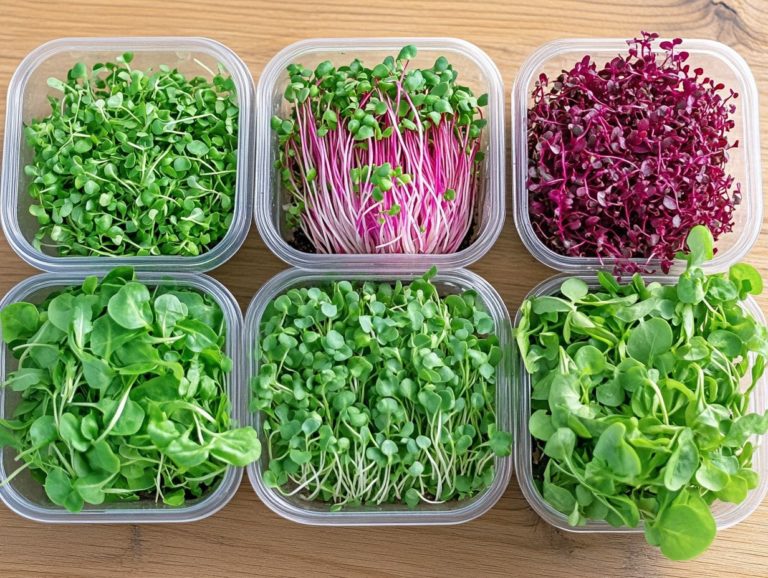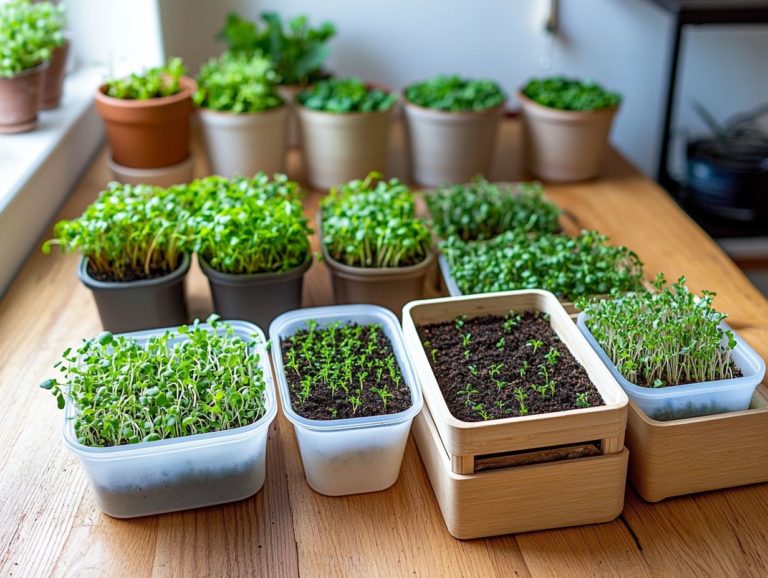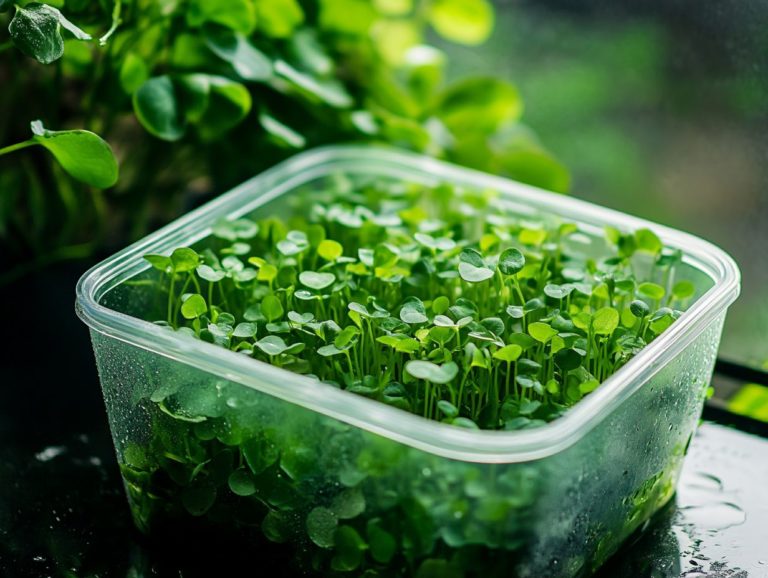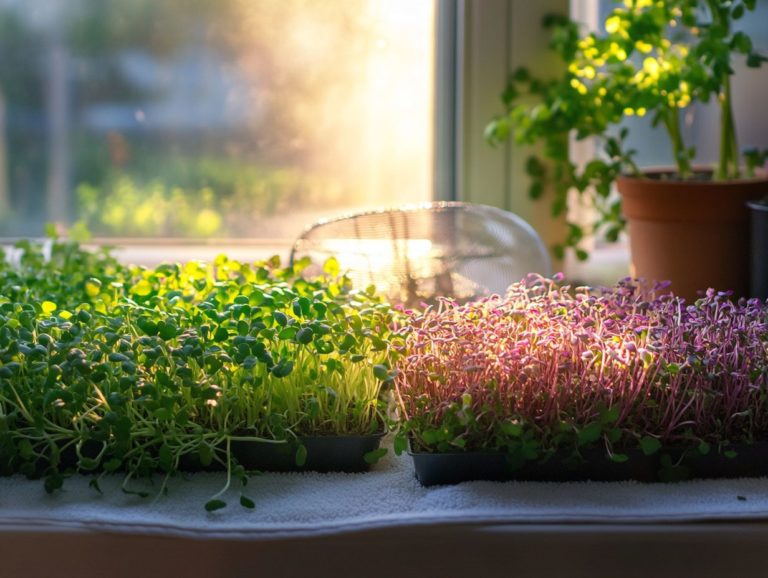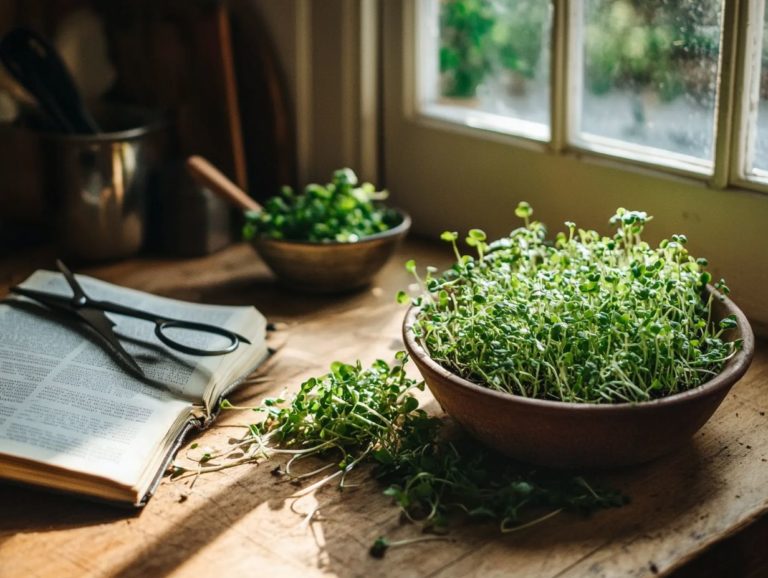5 Ways to Incorporate Microgreens into Your Diet
Microgreens are delightful, tiny powerhouses of nutrition. They can truly elevate your meals with vibrant flavors and remarkable health benefits.
In this article, you ll discover five delectable ways to incorporate microgreens into your diet. Whether you re tossing them into salads, layering them in sandwiches, or blending them into smoothies, there s an exciting option for every palate.
You ll learn what microgreens really are, explore their various types, and find out how to grow them right at home. Plus, you’ll receive valuable tips on maximizing their health benefits and some important precautions to consider.
Prepare to transform your culinary experience with these little greens!
Contents
- Key Takeaways:
- 1. Add Them to Salads
- 2. Use Them as a Topping for Sandwiches or Wraps
- 3. Blend Them into Smoothies
- 4. Incorporate Them into Omelettes or Scrambled Eggs
- 5. Sprinkle Them on Top of Soups or Stir-Fries
- What Are Microgreens and Why Are They Beneficial?
- Frequently Asked Questions
- What are microgreens and why should I incorporate them into my diet?
- What are some simple ways to add microgreens to my meals?
- Can I grow my own microgreens at home?
- What types of microgreens are best for beginners?
- Are there any potential risks or precautions I should be aware of when consuming microgreens?
- Can I incorporate microgreens into my diet if I have a limited budget?
Key Takeaways:

- Add microgreens to salads for extra nutrition and texture.
- Enhance sandwiches with flavorful microgreen toppings.
- Mix microgreens into smoothies for a nutrient boost and color.
1. Add Them to Salads
Incorporating microgreens into your salads is a superb way to elevate both flavor and health benefits. Picture a burst of fresh, vibrant tastes combined with essential nutrients, including vitamins and antioxidants that support your wellness. Microgreens like sunflower, pea shoots, and arugula not only add unique textures and flavors to your dishes but also serve as colorful toppings that elevate your salad game.
For example, sunflower microgreens offer a delightful nutty flavor that pairs beautifully with creamy ingredients like feta cheese or avocado. Arugula adds a peppery punch that complements sweet fruits such as strawberries or mango. When mixing these greens into your salads, consider balancing flavors with a variety of textures crunchy nuts, crisp cucumbers, and juicy tomatoes all work wonderfully together.
These microgreens are packed with essential vitamins A, C, and K, and minerals like iron and calcium. They are a fantastic addition to your diet if you’re looking to boost your health deliciously.
2. Use Them as a Topping for Sandwiches or Wraps
Microgreens are a fantastic addition to your sandwiches and wraps. They elevate these dishes with layers of flavor and nutrients, turning an ordinary meal into a gourmet delight filled with health benefits.
These tiny greens are often bursting with bold flavors and vibrant colors. They not only enhance the visual appeal of your dish but also deliver a treasure trove of vitamins and minerals that support your overall well-being.
When incorporating microgreens, think about pairing:
- Peppery arugula or radish sprouts with savory meats like smoked turkey for a delightful contrast.
- Sunflower microgreens with creamy spreads and light vegetables for a milder taste.
Each variety of microgreen offers unique flavor and health benefits. This allows you to easily customize flavors and boost nutrition in every bite.
3. Blend Them into Smoothies
Blending microgreens into your smoothies is a simple and delightful way to enhance your daily nutrient intake. You ll enjoy a refreshing drink that tastes great and supports your health.
These tiny powerhouses are brimming with essential vitamins, minerals, and antioxidants. For example, incorporating pea shoots introduces a sweet, mild flavor that harmonizes beautifully with tropical fruits like pineapple and mango. Alternatively, consider adding radish microgreens for a peppery kick, which pairs surprisingly well with berries or bananas, creating a unique flavor fusion.
By experimenting with various fruits and spices, like ginger or mint, you can transform your microgreen smoothies into nutrient-dense, satisfying beverages perfect for kickstarting your day on a high note.
4. Incorporate Them into Omelettes or Scrambled Eggs
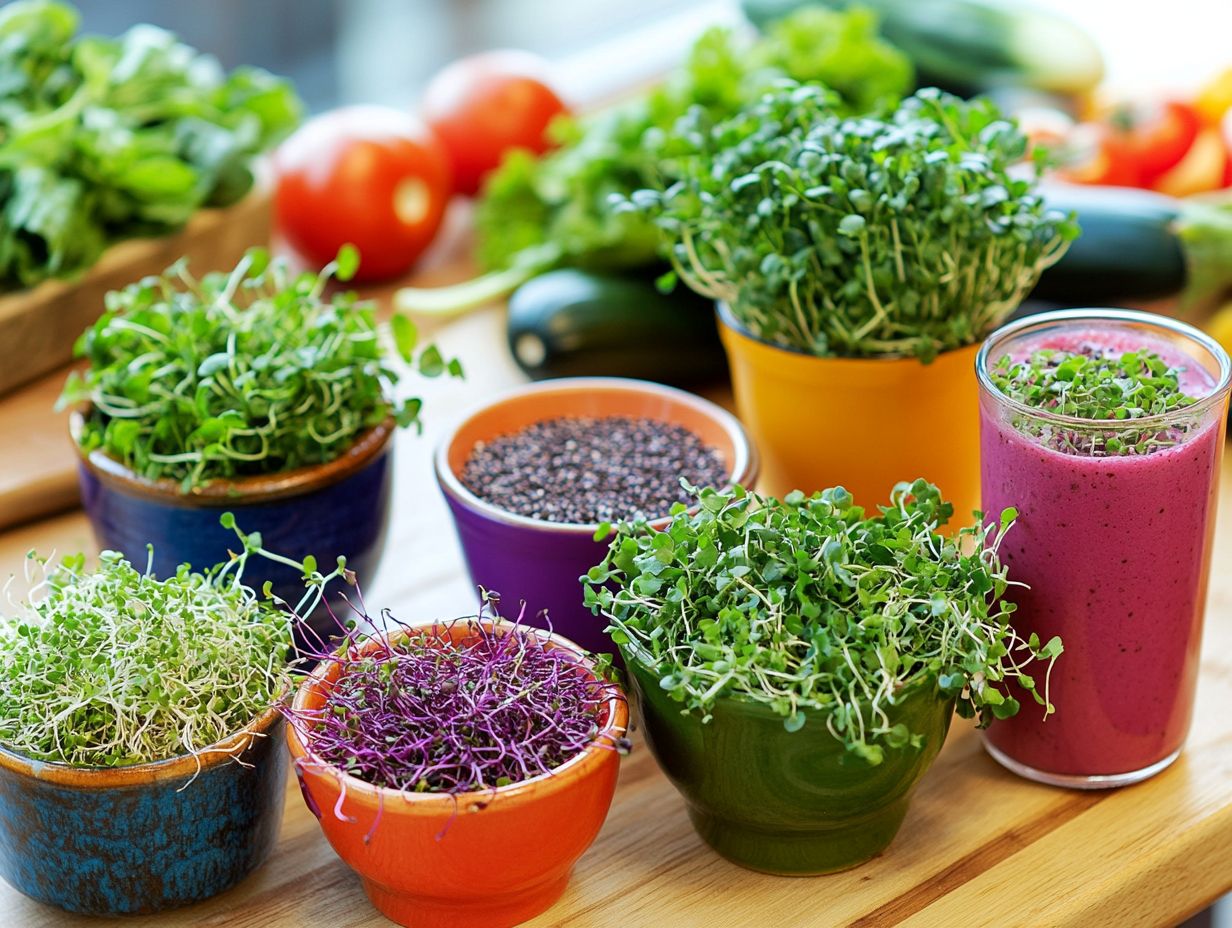
Incorporating microgreens into your omelettes or scrambled eggs enhances flavor and adds a nutritional punch. This makes your breakfast an effortless and healthy start to the day.
These vibrant greens, from the peppery kick of arugula to the sweet delicacy of pea shoots, offer a unique twist that can elevate any dish. They deliver essential vitamins and minerals while bringing an exciting burst of color and texture to your plate.
Transform your scrambled eggs into a flavor explosion with a sprinkle of radish microgreens or sunflower shoots, introducing a delightful crunch. You can also mix in a handful of basil microgreens for an aromatic, herb-infused experience.
In just a few minutes, you can turn a breakfast burrito or a classic egg sandwich into a gourmet morning delight, showcasing the versatility of these tiny greens.
5. Sprinkle Them on Top of Soups or Stir-Fries
Sprinkling microgreens atop your soups or stir-fries is a delightful way to elevate both the visual appeal and flavor of your dishes while providing essential nutrients for your health.
The vibrant colors and diverse textures of these tiny greens enhance your culinary presentation and introduce unique taste dimensions. Imagine the peppery kick of arugula microgreens cutting through a rich, creamy potato soup. Picture the mild sweetness of pea shoots beautifully complementing stir-fried vegetables.
The earthy notes of beet microgreens can transform hearty vegetable soups, adding both color and grounding taste. By thoughtfully selecting microgreens that align with your dish’s flavors, you can craft a harmonious and satisfying meal experience.
What Are Microgreens and Why Are They Beneficial?
Microgreens are young, edible wonders you can harvest just after the first true leaves appear. Known for their intense flavors and impressive nutrient density, these petite greens offer an array of health benefits, from boosting your immunity to enhancing overall wellness.
Sourced from various plant species, including herbs and vegetables, they re remarkably versatile and can elevate countless recipes. Whether grown in soil or through a method of growing plants in water without soil, microgreens grow at an astonishing pace, typically ready for your kitchen within 7 to 21 days.
These vibrant greens not only infuse a splash of color into your dishes but also enhance everything from salads and sandwiches to gourmet entrees.
Packed with vitamins, minerals, and antioxidants, incorporating microgreens into your diet may help reduce inflammation and support heart health. They are a delightful and nutritious ingredient to explore in your culinary adventures.
What Are the Different Types of Microgreens?
You ll find a remarkable variety of microgreens, each boasting distinct flavors and nutritional benefits. Popular options include sunflower, pea shoots, arugula, basil, mustard, and garlic. These little greens are perfect for elevating your culinary creations.
- Sunflower microgreens offer a nutty flavor that adds a delightful crunch to salads.
- Pea shoots bring a sweet, delicate taste that complements sandwiches and tacos.
- Arugula microgreens deliver a spicy kick, ideal for adding depth to dressings or serving as a vibrant garnish.
- Basil microgreens enhance pesto or tomato dishes with their aromatic sweetness, making them perfect for wraps and sandwiches.
- Mustard microgreens provide a zesty bite that livens up any plate.
- Garlic microgreens infuse flavor into dips and sauces, making them versatile staples in your kitchen.
Don’t miss out on adding these vibrant greens to your dishes; they ll elevate your meals instantly! Try them today and transform your culinary creations into something extraordinary!
How Can You Grow Microgreens at Home?
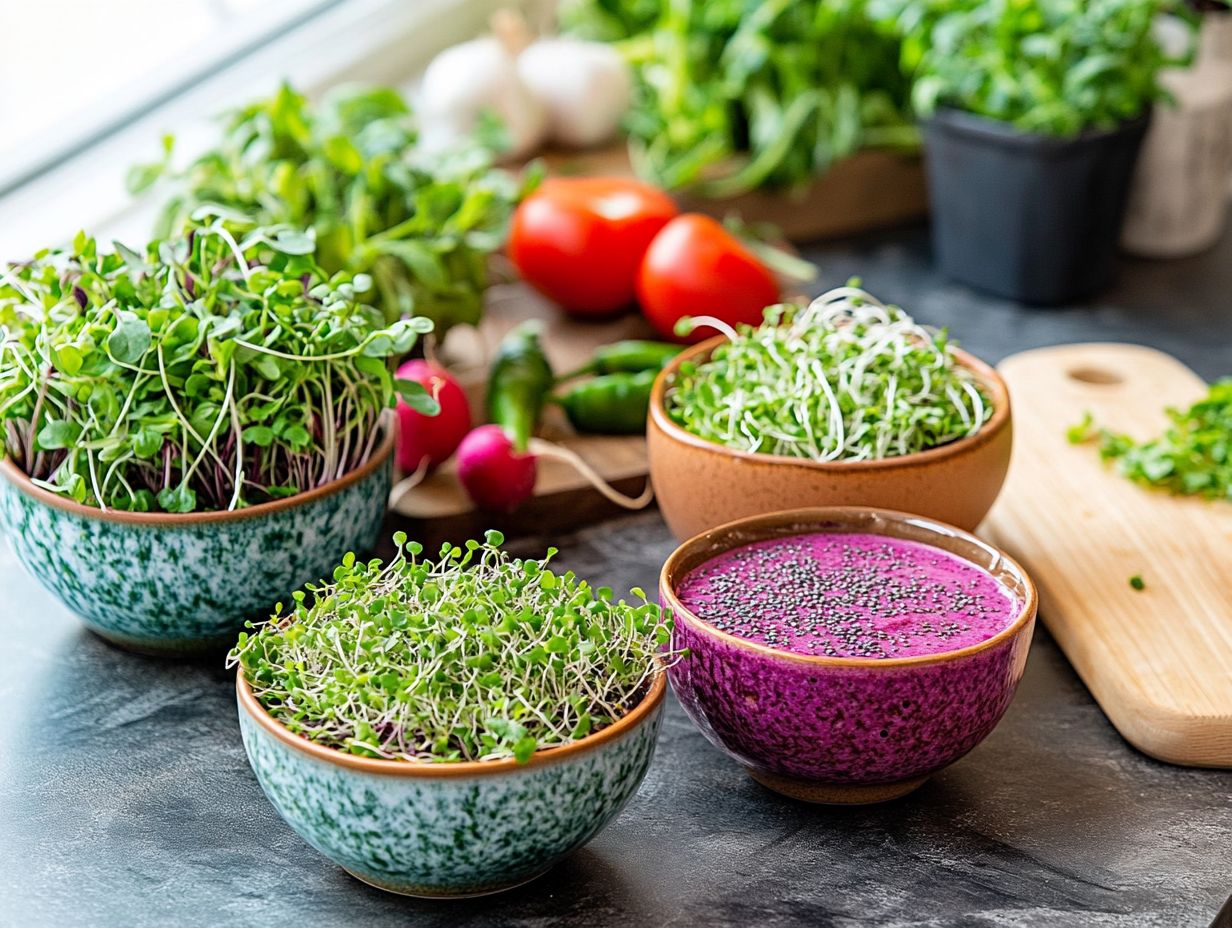
Growing microgreens at home is not just simple; it s a fulfilling endeavor that allows you to enjoy fresh, nutritious greens right from your kitchen. Picture this: a steady supply of fresh, nutritious ingredients right in your kitchen!
With just a bit of space be it a sunny windowsill or a dedicated shelf you can easily cultivate these miniature powerhouses. Microgreens are particularly celebrated for their vibrant flavors and impressive nutrient profiles.
You can choose from various methods to grow them, whether through traditional soil cultivation or water-based growing methods. Each method has its unique advantages, so it s vital for you to grasp the nuances.
Soil not only provides natural nutrients but also enhances flavor, while hydroponics, which means growing plants in water instead of soil, offers a soil-less approach that s often easier to maintain.
As you embark on this journey, you ll find the nutritional benefits of your homegrown microgreens to be an exciting reward. Packed with vitamins, minerals, and antioxidants, they far surpass their mature counterparts, making your efforts truly worthwhile.
What Are Some Other Creative Ways to Use Microgreens in Cooking?
Microgreens offer a plethora of creative possibilities in your cooking, effortlessly enhancing everything from tacos and sushi to snacks and various dishes, showcasing their remarkable versatility and health benefits.
These petite greens are not just visually appealing; they re bursting with flavor and nutrients, capable of transforming a simple salad into a gourmet delight or elevating a classic sandwich to new culinary heights.
By exploring different varieties, such as radish, basil, or beet microgreens, you can dive into an exciting realm of flavors and textures, making them suitable for both casual meals and upscale dining experiences. Additionally, consider exploring ways to enhance flavor in microgreens to elevate your dishes even further.
For example, tossing a handful of microgreens into a pasta dish can introduce a fresh, peppery kick. Using them as a garnish on soups or omelets enhances not just the visual allure but also adds a delightful burst of freshness.
Experimenting with various cuisines will reveal just how these small greens can beautifully complement and enrich a wide array of recipes.
Are There Any Risks or Precautions When Consuming Microgreens?
Microgreens are safe and healthy, but it’s smart to be aware of potential risks and take necessary precautions to fully enjoy their health benefits without any adverse effects.
Contamination can happen if the seeds, soil, or water used during growth aren t kept clean or are mishandled, leading to serious health concerns. To minimize these risks, ensure that you:
- Source seeds from reputable suppliers,
- Maintain a clean growing environment,
- Wash the microgreens thoroughly before consumption to support their health benefits.
Monitor humidity levels and avoid standing water to help prevent mold growth. If you’re growing your own, using sanitized containers and adhering to safe handling guidelines post-harvest will keep your microgreens fresh and safe to eat.
With these precautions in place, you can confidently incorporate these nutritious plants into your meals.
How Can You Ensure You Are Getting the Most Nutrients from Microgreens?
To truly maximize the nutrients and health benefits you can reap from microgreens, it’s crucial to focus on selection, storage, and preparation techniques that enhance their nutritional profile.
When you re selecting microgreens, aim for vibrant colors and firm leaves; these are your indicators of freshness and quality. Aromatic varieties often signify peak flavor and nutrient density, making them a wise choice.
Proper storage is just as essential; keeping them in a breathable container in the refrigerator will help maintain their crispness and extend their shelf life.
In terms of cooking, consider lightly steaming your microgreens or adding them to your dishes at the very end of cooking. This approach helps retain their beneficial compounds, ensuring you enjoy the full spectrum of health perks that microgreens have to offer.
These straightforward yet effective practices can make a significant difference in your culinary experience.
Ready to grow your own microgreens? Start today and discover the joy of fresh greens right at your fingertips!
Frequently Asked Questions
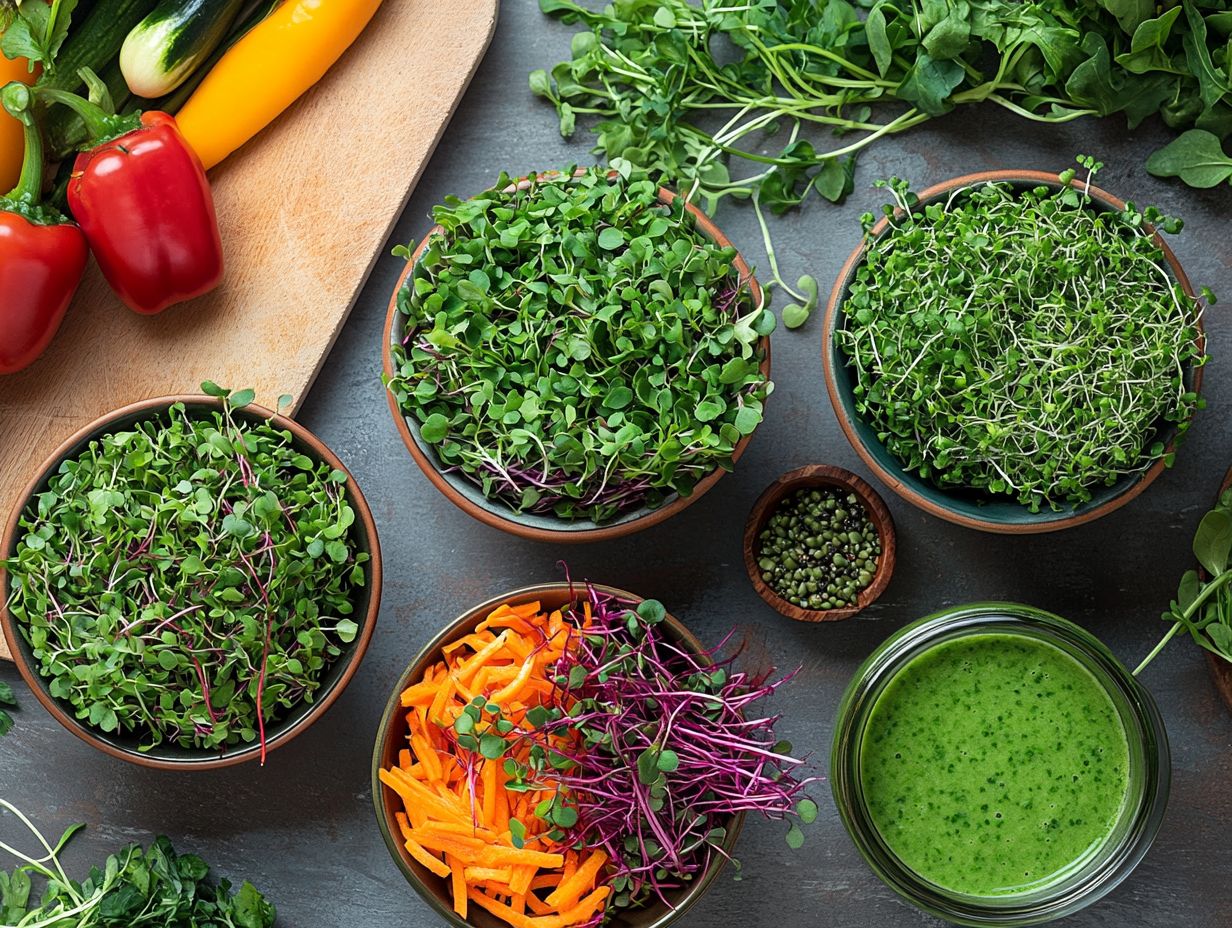
What are microgreens and why should I incorporate them into my diet?
Microgreens are young, edible greens that are bursting with nutrients and flavor. They offer a range of health benefits, including boosting your vitamin and mineral intake.
What are some simple ways to add microgreens to my meals?
Add microgreens to salads, sandwiches, and soups. They also make a delicious addition to smoothies and can be used as a garnish on cooked dishes.
Can I grow my own microgreens at home?
Absolutely! Growing microgreens at home is a fun and rewarding experience. You just need a shallow tray, potting soil, and seeds.
What types of microgreens are best for beginners?
Easy-to-grow options for beginners include sunflower, broccoli, and radish. These varieties grow quickly and are less finicky than others.
Are there any potential risks or precautions I should be aware of when consuming microgreens?
Microgreens are generally safe, but it’s essential to wash them thoroughly before eating. If you have allergies to certain greens, exercise caution. Consult a healthcare professional if you have concerns.
Can I incorporate microgreens into my diet if I have a limited budget?
Yes! Microgreens are a cost-effective way to boost nutrients and flavor in your meals. Look for them at local farmers’ markets for lower prices or grow them at home for extra savings.

